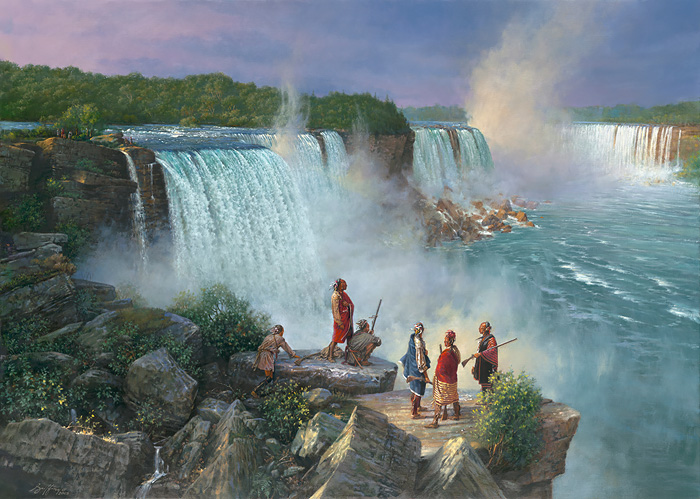Thundering Water
The Swedish naturalist Peter Kalm described Niagara Falls of the mid-eighteenth century in this way: “One could not gaze and contemplate without feelings of wonder and astonishment. The water seemed to flow gently and well-nigh lazily over the cliff at first; but the farther down it went, the greater the speed . . . In its descent, near the bottom, the water strikes the rock in some places and there it foams and froths and roars in gigantic leaps, so that it gives the impression of the continuous firing of canon . . . .” 53
In the Iroquois language, Niagara means thunder of water, and from the earliest of times, both Indians and whites have recognized the falls as a great natural wonder. Although beautiful, they could also be treacherous. Fish, deer, birds, and other wildlife were often caught in the current and swept over the falls. This view shows the falls from the American side, they way they appeared in the mid-eighteenth century.
Niagara Falls has always been a great subject for artists, so I guess it was my turn. I wanted to show the local Seneca Indians and their close relationship and reverence to the place they called the thunder of water. In 1775, the volume of water was much greater than it is today and the sound was deafening. I found it interesting that the Indians would go down to the base of the falls and collect wild game and fish that had gone over. It was an endless supply of food.
The Artist
.
Availability
Canvas Giclee
Size 25 3/4 x 36
Edition Size 125
$875
Signed and Numbered
Size 19 1/4 x 26 1/2
$195
Open Edition Prints
Size 8 x 10 1/2
$40
Call us to order
(716) 397-2331
PARAMOUNT PRESS
PO Box 302
Panama, New York 14767
716-397-2331
paramountpress@windstream.net
FOLLOW US
Copyright © 2022 Paramount Press, Inc.
All the art of Robert Griffing is protected under US Copyright Laws and must be contracted from Paramount Press, Inc to have a valid permission granted. For contracting consideration and use fee rates contact, Gerald Seymour at paramountpress@windstream.net.
